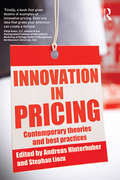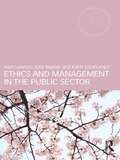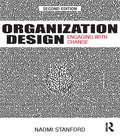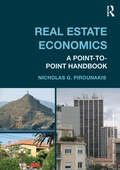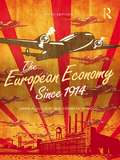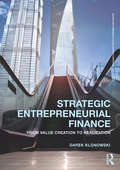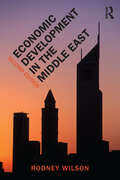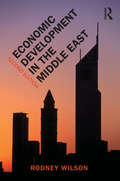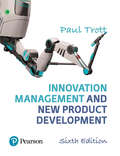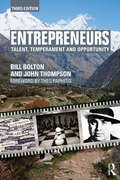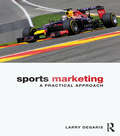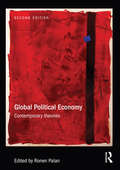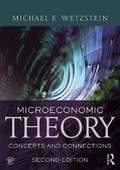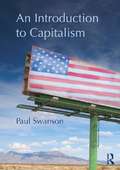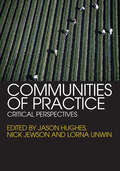- Table View
- List View
Innovation in Pricing: Contemporary Theories and Best Practices
by Andreas Hinterhuber Stephan M. LiozuPricing has a substantial and immediate impact on profitability. Most companies, however, still use costs or competition as a main basis for setting prices. Product or business model innovation has a high priority for many companies whereas innovation in pricing has received scant attention. This book examines how innovation in pricing can drive profits. The text examines innovation in pricing from four complementary perspectives. Innovation in Pricing Strategy illustrates how companies implement innovative pricing strategies, such as customer value-based pricing. Innovation in Pricing Tactics deals with innovative tools to measure and increase customer willingness to pay and to communicate value to B2B and B2C customers. Innovation in Organizing the Pricing Function looks at state-of-the art approaches to embed the pricing function in the organization. Psychological Aspects of Pricing illustrates how companies can influence customer perceptions of value and price in their question to implement innovation in pricing. This edited volume brings together 26 articles from academics, business practitioners and consultants. Authors are from the world’s largest companies, leading research-based universities and consulting companies specialized in pricing. This book is the only book dedicated to innovation in pricing and an essential read for business executives and pricing managers wishing to treat innovation in pricing as seriously as they treat product or business model innovation.
Innovation in Pricing: Contemporary Theories and Best Practices
by Andreas Hinterhuber Stephan M. LiozuPricing has a substantial and immediate impact on profitability. Most companies, however, still use costs or competition as a main basis for setting prices. Product or business model innovation has a high priority for many companies whereas innovation in pricing has received scant attention. This book examines how innovation in pricing can drive profits. The text examines innovation in pricing from four complementary perspectives. Innovation in Pricing Strategy illustrates how companies implement innovative pricing strategies, such as customer value-based pricing. Innovation in Pricing Tactics deals with innovative tools to measure and increase customer willingness to pay and to communicate value to B2B and B2C customers. Innovation in Organizing the Pricing Function looks at state-of-the art approaches to embed the pricing function in the organization. Psychological Aspects of Pricing illustrates how companies can influence customer perceptions of value and price in their question to implement innovation in pricing. This edited volume brings together 26 articles from academics, business practitioners and consultants. Authors are from the world’s largest companies, leading research-based universities and consulting companies specialized in pricing. This book is the only book dedicated to innovation in pricing and an essential read for business executives and pricing managers wishing to treat innovation in pricing as seriously as they treat product or business model innovation.
Ethics and Management in the Public Sector
by Alan Lawton Julie Rayner Karin LasthuizenGrappling with ethical issues is a daily challenge for those working in organizations that deliver public services. Such services are delivered through an often bewildering range of agencies and amidst this constant change, there are fears that a public service ethos, a tradition of working in the public interest, becomes blurred. Using extensive vignettes and case studies, Ethics and Management in the Public Sector illuminates the practical decisions made by public officials. The book takes a universal approach to ethics reflecting the world-wide impact of public service reforms and also includes discussions on how these reforms impact traditional vales and principles of public services. This easy-to-use textbook is a definitive guide for postgraduate students of public sector ethics, as well as students of public management and administration more generally.
Ethics and Management in the Public Sector
by Alan Lawton Julie Rayner Karin LasthuizenGrappling with ethical issues is a daily challenge for those working in organizations that deliver public services. Such services are delivered through an often bewildering range of agencies and amidst this constant change, there are fears that a public service ethos, a tradition of working in the public interest, becomes blurred. Using extensive vignettes and case studies, Ethics and Management in the Public Sector illuminates the practical decisions made by public officials. The book takes a universal approach to ethics reflecting the world-wide impact of public service reforms and also includes discussions on how these reforms impact traditional vales and principles of public services. This easy-to-use textbook is a definitive guide for postgraduate students of public sector ethics, as well as students of public management and administration more generally.
Organization Design: Engaging with Change
by Naomi StanfordAs the purse strings tighten company costs need to be cut without this affecting performance or sales. A common solution to this problem is to restructure the organization of the company i.e. adjust the lines and boxes on the organization chart with the aim of setting it up for high performance. This inevitably fails because an organization is a system; change one aspect and other facets will also change. Organization Design: Engaging with change looks at how to (re) design the organizational system in order to increase productivity, performance and value; providing the knowledge and methodology to design an agile organization capable of handling the kind of continuous organizational change that all businesses face. The book clarifies why and how organizations need to be in a state of readiness to design or redesign and emphasizes that people as well as business processes must be part of design considerations. Responding to developments across the world since the first edition, this book covers, among other topics: Technology changes that have impacted upon organizations Increased demands for ‘sustainability’ and corporate social responsibility The pressure on organizations to be smarter, more efficient and more effective Whilst the material on this subject targets a wide management audience, this book is specifically written for consultants, OD/HR practitioners and line managers working together to achieve the goal of organizational redesign for changing circumstances. Aided by a range of pedagogical features, this book is a must-read for students or practitioners involved in the field of organizational design, development and change.
Organization Design: Engaging with Change
by Naomi StanfordAs the purse strings tighten company costs need to be cut without this affecting performance or sales. A common solution to this problem is to restructure the organization of the company i.e. adjust the lines and boxes on the organization chart with the aim of setting it up for high performance. This inevitably fails because an organization is a system; change one aspect and other facets will also change. Organization Design: Engaging with change looks at how to (re) design the organizational system in order to increase productivity, performance and value; providing the knowledge and methodology to design an agile organization capable of handling the kind of continuous organizational change that all businesses face. The book clarifies why and how organizations need to be in a state of readiness to design or redesign and emphasizes that people as well as business processes must be part of design considerations. Responding to developments across the world since the first edition, this book covers, among other topics: Technology changes that have impacted upon organizations Increased demands for ‘sustainability’ and corporate social responsibility The pressure on organizations to be smarter, more efficient and more effective Whilst the material on this subject targets a wide management audience, this book is specifically written for consultants, OD/HR practitioners and line managers working together to achieve the goal of organizational redesign for changing circumstances. Aided by a range of pedagogical features, this book is a must-read for students or practitioners involved in the field of organizational design, development and change.
Real Estate Economics: A Point-to-Point Handbook
by Nicholas G PirounakisReal Estate Economics: A point-to-point handbook introduces the main tools and concepts of real estate (RE) economics. It covers areas such as the relation between RE and the macro-economy, RE finance, investment appraisal, taxation, demand and supply, development, market dynamics and price bubbles, and price estimation. It balances housing economics with commercial property economics, and pays particular attention to the issue of property dynamics and bubbles – something very topical in the aftermath of the US house-price collapse that precipitated the global crisis of 2008. This textbook takes an international approach and introduces the student to the necessary ‘toolbox’ of models required in order to properly understand the mechanics of real estate. It combines theory, technique, real-life cases, and practical examples, so that in the end the student is able to: • read and understand most RE papers published in peer-reviewed journals; • make sense of the RE market (or markets); and • contribute positively to the preparation of economic analyses of RE assets and markets soon after joining any company or other organization involved in RE investing, appraisal, management, policy, or research. This book should be particularly useful to third-year students of economics who may take up RE or urban economics as an optional course, to postgraduate economics students who want to specialize in RE economics, to graduates in management, business administration, civil engineering, planning, and law who are interested in RE, as well as to RE practitioners and to students reading for RE-related professional qualifications.
Real Estate Economics: A Point-to-Point Handbook
by Nicholas G PirounakisReal Estate Economics: A point-to-point handbook introduces the main tools and concepts of real estate (RE) economics. It covers areas such as the relation between RE and the macro-economy, RE finance, investment appraisal, taxation, demand and supply, development, market dynamics and price bubbles, and price estimation. It balances housing economics with commercial property economics, and pays particular attention to the issue of property dynamics and bubbles – something very topical in the aftermath of the US house-price collapse that precipitated the global crisis of 2008. This textbook takes an international approach and introduces the student to the necessary ‘toolbox’ of models required in order to properly understand the mechanics of real estate. It combines theory, technique, real-life cases, and practical examples, so that in the end the student is able to: • read and understand most RE papers published in peer-reviewed journals; • make sense of the RE market (or markets); and • contribute positively to the preparation of economic analyses of RE assets and markets soon after joining any company or other organization involved in RE investing, appraisal, management, policy, or research. This book should be particularly useful to third-year students of economics who may take up RE or urban economics as an optional course, to postgraduate economics students who want to specialize in RE economics, to graduates in management, business administration, civil engineering, planning, and law who are interested in RE, as well as to RE practitioners and to students reading for RE-related professional qualifications.
The European Economy Since 1914
by Derek Aldcroft Steven MorewoodThe fifth edition of The European Economy provides a succinct and lucid account of the development and problems of the European economy since the first world war. It covers the whole of Europe including Russia and Turkey. The text divides into several clearly defined sub-periods: the impact and aftermath of the first world war and recovery and reconstruction during the 1920s; the depression and the recovery of the 1930s; the impact of the second world war and the new political division in Europe; the post-war boom of the 1950s and 1960s and then into the growth slowdown of the 1970s and the persistent problems of inflation and unemployment. It then analyses the demise of the centrally planned economies of eastern Europe and the move to a more united Europe and then discusses the financial and economic problems that have emerged in the early twenty-first century. This new edition has been extensively revised, new chapters have been added and the reading lists updated. Though the volume is designed as a basic introductory text the authors elicit some of the lessons that can be learnt from a study of past development, one of which is the limited power of governments to influence the course of events and to combat the operation of market forces.
The European Economy Since 1914
by Derek Aldcroft Steven MorewoodThe fifth edition of The European Economy provides a succinct and lucid account of the development and problems of the European economy since the first world war. It covers the whole of Europe including Russia and Turkey. The text divides into several clearly defined sub-periods: the impact and aftermath of the first world war and recovery and reconstruction during the 1920s; the depression and the recovery of the 1930s; the impact of the second world war and the new political division in Europe; the post-war boom of the 1950s and 1960s and then into the growth slowdown of the 1970s and the persistent problems of inflation and unemployment. It then analyses the demise of the centrally planned economies of eastern Europe and the move to a more united Europe and then discusses the financial and economic problems that have emerged in the early twenty-first century. This new edition has been extensively revised, new chapters have been added and the reading lists updated. Though the volume is designed as a basic introductory text the authors elicit some of the lessons that can be learnt from a study of past development, one of which is the limited power of governments to influence the course of events and to combat the operation of market forces.
Strategic Entrepreneurial Finance: From Value Creation to Realization
by Darek KlonowskiEntrepreneurial finance is a discipline that studies financial resource mobilization, resource allocation, risk moderation, optimization in financial contracting, value creation, and value monetization within the context of entrepreneurship.? However, without proper strategic consideration the discipline is incomplete. This book examines how the activity of entrepreneurial finance can be enhanced via a concentration on value creation and through improved strategic decision-making. The most unique feature of the book is its focus on value creation. For entrepreneurs, value creation is not a one-off activity, but rather a continuous cycle of incremental improvements across a wide range of business activities.? Entrepreneurial value creation is described in four comprehensive stages: value creation, value measurement, value enhancement, and value realization, referred to as the C-MER model. This book focuses on what creates value rather than merely presenting value creation in a straight accounting framework. At the same time, deliberate and tactical planning and implementation ensure that the firm does not ignore the components necessary for it to survive and flourish.Vigorous strategic deliberations maximize the entrepreneurial firm’s chances of making the right business decisions for the future, enable the firm to manage its available financial and non-financial resources in the most optimal manner, ensure that the necessary capital is secured to progress the development of the firm to its desired development level, and build value. While financial considerations are important, the field of strategic entrepreneurial finance represents a fusion of three disciplines: strategic management, financial management, and entrepreneurship. This orientation represents a natural evolution of scholarship to combine specific domains and paradigms of naturally connected business disciplines and reflects the need to simultaneously examine business topics from different perspectives which may better encapsulate actual entrepreneurial practices.
Strategic Entrepreneurial Finance: From Value Creation to Realization
by Darek KlonowskiEntrepreneurial finance is a discipline that studies financial resource mobilization, resource allocation, risk moderation, optimization in financial contracting, value creation, and value monetization within the context of entrepreneurship.? However, without proper strategic consideration the discipline is incomplete. This book examines how the activity of entrepreneurial finance can be enhanced via a concentration on value creation and through improved strategic decision-making. The most unique feature of the book is its focus on value creation. For entrepreneurs, value creation is not a one-off activity, but rather a continuous cycle of incremental improvements across a wide range of business activities.? Entrepreneurial value creation is described in four comprehensive stages: value creation, value measurement, value enhancement, and value realization, referred to as the C-MER model. This book focuses on what creates value rather than merely presenting value creation in a straight accounting framework. At the same time, deliberate and tactical planning and implementation ensure that the firm does not ignore the components necessary for it to survive and flourish.Vigorous strategic deliberations maximize the entrepreneurial firm’s chances of making the right business decisions for the future, enable the firm to manage its available financial and non-financial resources in the most optimal manner, ensure that the necessary capital is secured to progress the development of the firm to its desired development level, and build value. While financial considerations are important, the field of strategic entrepreneurial finance represents a fusion of three disciplines: strategic management, financial management, and entrepreneurship. This orientation represents a natural evolution of scholarship to combine specific domains and paradigms of naturally connected business disciplines and reflects the need to simultaneously examine business topics from different perspectives which may better encapsulate actual entrepreneurial practices.
Economic Development in the Middle East, 2nd edition
by Rodney WilsonBy examining economic development in the Middle East in the aftermath of the Arab Spring, this textbook introduces undergraduate and postgraduate students to the most pressing and topical economic issues in the contemporary Middle East. With comprehensive coverage of the entire region, the author examines the economic prospects for the Gulf and charts the growth of economic power in the region. Organised thematically, a full range of topics are discussed, including: the role of banks and capital markets in the region’s development the impact of demographic changes, such as the dramatic decline in birth rates and the implications for future employment the development of economic advances in oil and gas production the effects of the region’s economic development on international and inter-regional trade. Through discussing the region’s problems of the past as well as the present and future challenges, this book provides students with a compact and manageable review of the state of economic development in the Middle East.
Economic Development in the Middle East, 2nd edition
by Rodney WilsonBy examining economic development in the Middle East in the aftermath of the Arab Spring, this textbook introduces undergraduate and postgraduate students to the most pressing and topical economic issues in the contemporary Middle East. With comprehensive coverage of the entire region, the author examines the economic prospects for the Gulf and charts the growth of economic power in the region. Organised thematically, a full range of topics are discussed, including: the role of banks and capital markets in the region’s development the impact of demographic changes, such as the dramatic decline in birth rates and the implications for future employment the development of economic advances in oil and gas production the effects of the region’s economic development on international and inter-regional trade. Through discussing the region’s problems of the past as well as the present and future challenges, this book provides students with a compact and manageable review of the state of economic development in the Middle East.
Innovation Management and New Product Development
by Dr Paul TrottInnovation Management and New Product development is an established, text for MBA, MSc and advanced undergraduate courses on innovation management, management of technology, new product development and entrepreneurship. It is also widely used by practitioners of innovation. Now in its sixth edition, Innovation Management & New Product Development has been fully revised. Its clear and informed coverage of the management processes of new product development, coupled with a practical orientation of taking you through real life challenges and dilemmas, results in a book that brings together the most up-to-date and accessible discussion of the literature in this area, as well as a wealth of examples and illustrations in every chapter. New to this edition Three new chapters on Entrepreneurship and National Systems of Innovation; Business Models; and Adoption and diffusion. Thoroughly revised and updated chapters including new coverage of process innovation, user driven innovation, and imitation goods. New case studies on Drones, Apple and disposable nappies with sensors as well as updated case studies including 3M, eBay/PayPal and Gore-Tex® New 'Innovation In Action' feature in every chapter – practical examples of innovation in action that help you to link theory with practice Online resources available at www.pearsoned.co.uk/trott include PowerPoint slides and an Instructor’s Manual for lecturers. Aimed at students taking courses in business studies and management, as well as non-specialist courses in other disciplines, this book provides a practical and accessible evidence-based approach to managing innovation in a wide range of contexts, including: manufacturing, services, small to large organisations and the private and public sectors. About the AuthorPaul Trott is Professor of Innovation Management at the Business School, University of Portsmouth and Professor of Innovation Management & Entrepreneurship at The Technical University of Delft, The Netherlands. His research is widely cited and is published in many journals including Research Policy, R&D Management, Technovation, International Journal of Innovation Management and Marketing Management.
Principles of Environmental Economics and Sustainability: An Integrated Economic and Ecological Approach
by Ahmed HussenRecent years have witnessed considerable consolidation between the disciplines of environmental and ecological economics at research level, but until now textbooks in the area have done little to reflect this. Ahmed Hussen’s book is to date the only one to reconcile the two standpoints. The central focus of the book will continue to be on this systematic integration of both mainstream and ecological approaches to environmental economics, and an acknowledgement that enduring solutions to major contemporary environmental challenges can be obtained through studies based on a well-conceived and balanced interdisciplinary approach. However, this third edition also contains much that is new. Chiefly, brand new chapters appear covering the following topics: The economics of climate change The economics of biodiversity and ecosystem services ‘Green’ accounting and alternative economic and social indicators of sustainability The business case for environmental sustainability An Appendix that provides a brief historical account of the development of ecological economics The result is a comprehensive introduction to the main facets of environmental and ecological economics — a text that boldly refuses to put up barriers between disciplines and takes a holistic approach to vital issues. This student-friendly textbook contains a variety of study tools including learning points, boxed features, case studies, revision questions and discussion questions, and an Appendix that provides students with a review of basic economic principles relevant to the study of the environment and its management. Written in a clear and accessible style, this book will prove an excellent choice for introducing both students and academics to the world of environmental economics.
Principles of Environmental Economics and Sustainability: An Integrated Economic and Ecological Approach
by Ahmed HussenRecent years have witnessed considerable consolidation between the disciplines of environmental and ecological economics at research level, but until now textbooks in the area have done little to reflect this. Ahmed Hussen’s book is to date the only one to reconcile the two standpoints. The central focus of the book will continue to be on this systematic integration of both mainstream and ecological approaches to environmental economics, and an acknowledgement that enduring solutions to major contemporary environmental challenges can be obtained through studies based on a well-conceived and balanced interdisciplinary approach. However, this third edition also contains much that is new. Chiefly, brand new chapters appear covering the following topics: The economics of climate change The economics of biodiversity and ecosystem services ‘Green’ accounting and alternative economic and social indicators of sustainability The business case for environmental sustainability An Appendix that provides a brief historical account of the development of ecological economics The result is a comprehensive introduction to the main facets of environmental and ecological economics — a text that boldly refuses to put up barriers between disciplines and takes a holistic approach to vital issues. This student-friendly textbook contains a variety of study tools including learning points, boxed features, case studies, revision questions and discussion questions, and an Appendix that provides students with a review of basic economic principles relevant to the study of the environment and its management. Written in a clear and accessible style, this book will prove an excellent choice for introducing both students and academics to the world of environmental economics.
Entrepreneurs: Talent, Temperament and Opportunity (3rd Edition)
by Bill BoltonIf you have an interest in things entrepreneurial and wonder if you have what it takes to be a successful entrepreneur, then this book is written for you. Authors Bill Bolton and John Thompson offer aunique focus, seeing everything through the eyes of the entrepreneur. Thisrefreshed thirdedition is split into two fascinating parts. Part I builds an understanding of the entrepreneur as a person based on the key factors of talent and temperament - a unique framework for understanding and exploiting entrepreneurial opportunities. The process of starting and growing a business and the infrastructure and environment in which the entrepreneur has to operate, are described in detail. Part II tells the stories of famous entrepreneurs including classic figures such as Henry Ford, through to social entrepreneurs and even anti-social entrepreneurs such as Al Capone! This insightful, empirically based, originaltake on the entrepreneur, and therebyentrepreneurship, provides students with a new and challenging way into the subject.
Entrepreneurs: Talent, Temperament and Opportunity (3rd Edition) (PDF)
by Bolton, Bill|Thompson, JohnIf you have an interest in things entrepreneurial and wonder if you have what it takes to be a successful entrepreneur, then this book is written for you. Authors Bill Bolton and John Thompson offer aunique focus, seeing everything through the eyes of the entrepreneur. Thisrefreshed thirdedition is split into two fascinating parts. Part I builds an understanding of the entrepreneur as a person based on the key factors of talent and temperament - a unique framework for understanding and exploiting entrepreneurial opportunities. The process of starting and growing a business and the infrastructure and environment in which the entrepreneur has to operate, are described in detail. Part II tells the stories of famous entrepreneurs including classic figures such as Henry Ford, through to social entrepreneurs and even anti-social entrepreneurs such as Al Capone! This insightful, empirically based, originaltake on the entrepreneur, and therebyentrepreneurship, provides students with a new and challenging way into the subject.
Sports Marketing: A Practical Approach
by Larry DeGarisAny sports marketing student or prospective sports marketer has to understand in detail genuine industry trends and be able to recognise solutions to real-world scenarios. Sports Marketing: A Practical Approach is the first textbook to offer a comprehensive, engaging and practice-focused bridge between academic theory and real-life, industry-based research and practice. Defining the primary role of the sports marketer as revenue generation, the book is structured around the three main channels through which this can be achieved — ticket sales, media and sponsorship — and explores key topics such as: Sports markets and business markets (b2b) Fan development Brand management Media audiences, rights and revenue Live sports events Sponsorship Merchandise and retail Integrating real industry-generated research into every chapter, the book also includes profiles of leading industry executives and guidance for developing and preparing for a career in sports marketing. It goes further than any other sports marketing textbook in surveying the international sports market, including international cases and detailed profiles of international consumer and business markets throughout. A companion website offers multiple choice questions for students, editable short answer and essay questions, and lecture slides for instructors. No other textbook offers such a relevant, practice-focused overview of contemporary sports marketing. It is the ideal companion to any sports marketing course.
Global Political Economy: Contemporary Theories
by Ronen PalanGlobal Political Economy (GPE) is a broad and varied field of study and draws insight from a great number of fields and approaches. One of the serious problems confronting academics and students is the sheer mass of theories and debates in the field. This textbook provides up-to-date summaries of the debates and approaches that are currently at the forefront of both European and American GPE. This new revised and expanded second edition contains updated versions of most of the original chapters. In addition, there is a new section entitled ‘Emerging issues in contemporary Global Political Economy (GPE)’ and six new chapters. The second edition is structured around three themes: Part I focuses on the six central concepts of GPE: state, firm, power, labour, finance and globalization. Each one of them has been increasingly subjected to a rigorous and critical evaluation in recent scholarship. Part II covers a select number of theories and debates currently at the forefront of GPE: game theory; behavioural economics; neo-, sociological and evolutionary institutionalism; neo-Marxism; development and post-development; libidinal economies; and economic constructivism. Part III, which is new to this edition, is entitled ‘Emerging issues in contemporary Global Political Economy (GPE)’ and focuses on war, state and International Political Economy (IPE); race, gender and culture; environmental politics; and the rise of China. This is essential reading for all serious scholars and advanced students of IPE.
Microeconomic Theory second edition: Concepts and Connections
by Michael E. WetzsteinThis book introduces the main concepts of microeconomics to upper division undergraduate students or first year graduate students who have undergone at least one elementary calculus course. The book fully integrates graphical and mathematical concepts and offers over 150 analytical examples demonstrating numerical solutions. The book has a strong theoretical basis but shows how microeconomics can be brought to bear on the real world. New Features for this edition include: an incorporation of the theory of stock externalities associated with greenhouse gases development of the section on insurance with particular reference to the new US healthcare program greater integration of game theoretic concepts throughout the book. The book’s style is accessible, but also rigorous. Mathematical examples are provided throughout the book, in particular for key concepts and the result is a balanced approach in terms of prose, graphics, and mathematics.
An Introduction to Capitalism
by Paul SwansonEmbedded in an historical account of the development of U.S. capitalism up to the present day, this book gives the reader a thorough description of the major aspects of the U.S. economy, as well as a theoretical understanding of the overall economy. A particular focus of this book is how free markets work in capitalism and the interrelationship between markets and the government. Of particular interest in the current economic situation is the question of what can the government do to get the economy going again. Underlying the standard economics text today is the fundamental belief that leaving markets as free as possible will lead to the ideal economy. Directly opposing this approach, this book takes a critical stance toward free markets. Rather than viewing markets as the ideal solution to almost all economic problems, this book argues that markets are not always the answer. On the contrary, they are often the problem, and must be corrected by government action. Related to this critical stance, and in a further departure from current economics texts, this book takes an explicitly Keynesian approach to the macro-economy. Rejecting the free market approach which dominates both micro- and macro-economics today, this book offers a fresh perspective on economics and the economy today.
An Introduction to Capitalism
by Paul SwansonEmbedded in an historical account of the development of U.S. capitalism up to the present day, this book gives the reader a thorough description of the major aspects of the U.S. economy, as well as a theoretical understanding of the overall economy. A particular focus of this book is how free markets work in capitalism and the interrelationship between markets and the government. Of particular interest in the current economic situation is the question of what can the government do to get the economy going again. Underlying the standard economics text today is the fundamental belief that leaving markets as free as possible will lead to the ideal economy. Directly opposing this approach, this book takes a critical stance toward free markets. Rather than viewing markets as the ideal solution to almost all economic problems, this book argues that markets are not always the answer. On the contrary, they are often the problem, and must be corrected by government action. Related to this critical stance, and in a further departure from current economics texts, this book takes an explicitly Keynesian approach to the macro-economy. Rejecting the free market approach which dominates both micro- and macro-economics today, this book offers a fresh perspective on economics and the economy today.
Communities of Practice: Critical Perspectives
by Jason Hughes Nick Jewson Lorna UnwinThis benchmark text provides an accessible yet critical introduction to the theory and application of communities of practice and their use in a diverse range of managerial and professional contexts, from education to human resource development. This book charts the development of the idea of communities of practice and explores the key relationship between learning and identity among: newcomers and ‘old timers’ male and female workers the low skilled and the high skilled professionals and managers adults and adolescents. Drawing on international empirical studies and adopting a multi-disciplinary approach, this book is useful reading for all students, researchers, practitioners and policy makers with an interest in work, employment, labour markets, learning, training or education.
